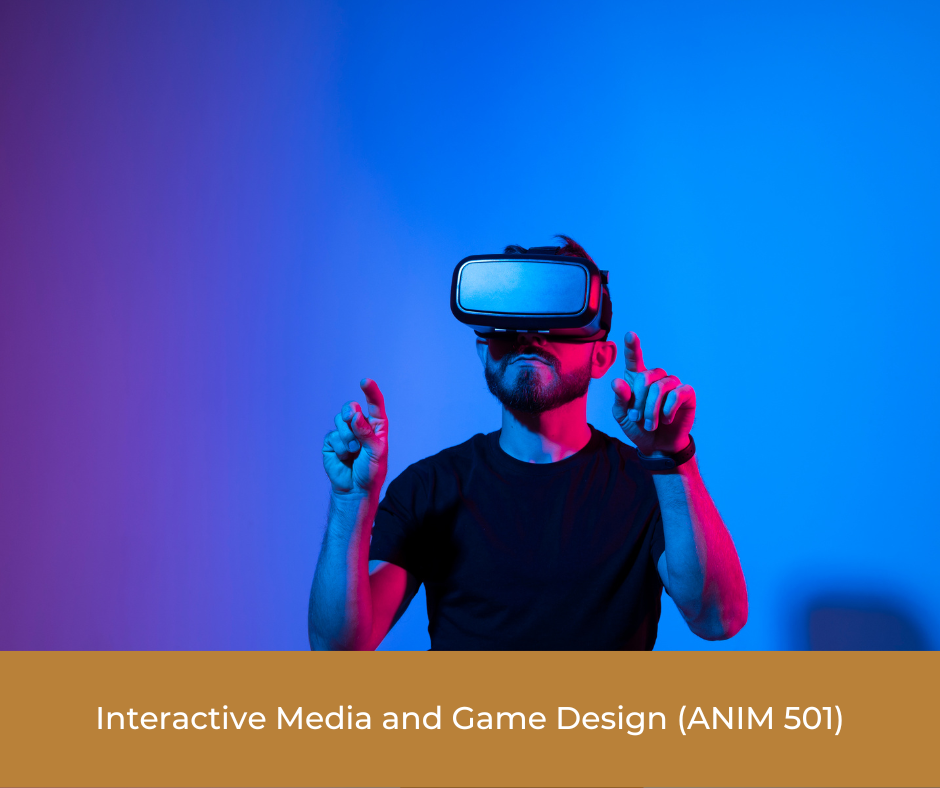Your cart is currently empty!
Interactive Media and Game Design (ANIM 501)

Course Description
Interactive Media and Game Design (ANIM 501) is a dynamic course that immerses students in the world of interactive media and game design. This course introduces fundamental concepts in interactive storytelling, game mechanics, and user experience (UX) design. Students will create interactive animations, design game assets, and gain a deeper understanding of user-centric design principles.
Outline of Major Content Areas
- Introduction to Interactive Media: An overview of interactive media and its role in modern entertainment and communication.
- Game Design Principles: Explores the core principles of game design, including game mechanics, player motivation, and game dynamics.
- Interactive Storytelling: Focuses on techniques for creating compelling interactive narratives and storytelling in games.
- User Experience (UX) Design: Introduces UX design principles and methods for creating user-friendly interactive experiences.
- Game Asset Creation: Teaches students to create game assets, including characters, objects, and environments.
- Prototyping and Playtesting: Emphasizes the importance of prototyping and playtesting in the game design process.
- Game Engines and Tools: Familiarizes students with game development engines and software tools used in the industry.
- Interactive Animation Techniques: Explores animation techniques specific to interactive media and game design.
- Sound and Music in Interactive Media: Examines the role of sound and music in enhancing the user experience in interactive media and games.
- Project Development: Students work on hands-on projects to apply their knowledge in interactive media and game design.
Course Learning Outcomes
Upon completing Interactive Media and Game Design (ANIM 501), students will:
- Game Design Proficiency: Demonstrate a solid understanding of fundamental game design principles, including game mechanics and dynamics.
- Interactive Storytelling: Create engaging interactive narratives for games and interactive media.
- User-Centric Design: Apply user experience (UX) design principles to ensure interactive media is user-friendly and engaging.
- Game Asset Creation: Develop game assets, including characters, objects, and environments, suitable for interactive media.
- Prototyping and Playtesting: Employ prototyping and playtesting techniques to refine and improve interactive media and game concepts.
- Game Engines and Tools: Utilize industry-standard game development engines and tools effectively.
- Interactive Animation Skills: Implement interactive animation techniques to enhance user engagement.
- Sound and Music Integration: Integrate sound and music effectively to enhance the immersive experience of interactive media and games.
- Project Execution: Successfully execute interactive media and game design projects, applying learned concepts and skills.
Methods for Assessing Student Learning
Assessment in Interactive Media and Game Design (ANIM 501) focuses on evaluating students’ proficiency in interactive media and game design. Assessment methods include:
- Game Design Projects: Evaluation of game design projects, assessing game mechanics, narrative, and player engagement.
- Interactive Storytelling Assignments: Assessment of interactive storytelling assignments, including interactive narrative structure and user engagement.
- User Experience (UX) Design Tasks: Evaluation of UX design tasks, measuring the usability and user-centric design of interactive media.
- Game Asset Creation Projects: Review of game asset creation projects, including characters, objects, and environments for games.
- Prototyping and Playtesting Reports: Assessment of prototyping and playtesting reports, focusing on the iterative design process.
- Game Engine Proficiency: Examination of students’ ability to effectively use game development engines and software tools.
- Interactive Animation Projects: Evaluation of interactive animation projects, emphasizing user engagement through animation.
- Sound and Music Integration Projects: Assessment of sound and music integration projects, considering their impact on the overall user experience.
- Project Execution and Presentation: Evaluation of students’ ability to successfully execute interactive media and game design projects and their presentation skills.
Interactive Media and Game Design (ANIM 501) equips students with the knowledge and skills needed to excel in the rapidly evolving field of interactive media and game design. By mastering game design principles, interactive storytelling, UX design, and game asset creation, students will be well-prepared to create engaging and immersive interactive experiences.